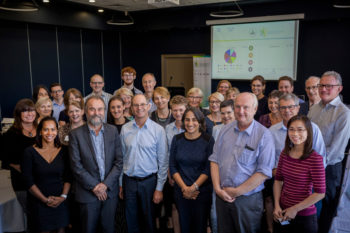Building a compelling case for prevention – Phase 1

Status completed
Start Date
End Date
Despite the burden of lifestyle-related chronic disease and the opportunities for prevention, only a small percentage of Australian government budgets for health care is spent on prevention.
Our online simulation proof-of-concept model demonstrates the potential of dynamic simulation methods to make a compelling case for investing in the prevention of chronic disease.
Introduction
Although we can forecast the health burden of chronic diseases and the impact of individual risk factors, existing modelling does not consider what happens in the real world.
This project developed a proof-of-concept model, users can understand how the assumptions behind interventions may or may not influence their impact at a population level.
This engaging and useful tool illustrates the health benefits and economic value of prevention interventions to individuals, the health system and Australian productivity. The second phase of this project started in 2019 and aims to extend the scope of the model, read more about Phase 2 here.
Featured project resources
-
More investment in robust data is needed to support our case for chronic disease prevention
Resource category:Findings Brief
Date -
Building a compelling case for prevention: Computational modelling of health and economic benefits of chronic disease prevention interventions in Australia
Resource category:Reports
Date -
Building a case for prevention using dynamic simulation modelling
Resource category:Factsheets
Date -
A ‘what if’ tool to better understand complex health problems
Resource category:Videos
Date
Featured project news
-
Australia’s first national model of chronic disease burden
News Category: Prevention Centre NewsDate -
Modelling drives innovation to prove the case for prevention
News Category: Prevention Centre NewsDate -
Making the compelling case for prevention
News Category: Prevention Centre NewsDate
About
Developing a compelling case for prevention
Project titleWhat is the issue?
Chronic diseases are a serious and increasing problem. The associated economic burden not only affects individuals and the health system, it also adversely affects workplace productivity, economic growth and participation across the full range of domestic and workplace activities.
Fortunately, many major chronic diseases are largely preventable through changes to key risk factors: poor diet, physical inactivity, tobacco use, harmful alcohol consumption and obesity.
Despite the burden of lifestyle-related chronic disease and the opportunities for prevention, only a small percentage of Australian government budgets for health care is spent on prevention.
How did the project address the issue?
The overall objectives of the project were to:
- Demonstrate the scale and scope of benefits from preventing the most prevalent modifiable risk factors, namely poor diet, physical inactivity, tobacco use, harmful alcohol consumption and overweight and obesity
- Develop and demonstrate the value of a range of interventions to reduce preventable chronic disease, assessing both effectiveness and value for money
- Develop and make readily available innovative, accessible and compelling messaging about the value of reducing preventable chronic disease.
The project had three main parts:
- Literature review and data collation – The project team collated evidence about the health and economic burden of chronic disease, its preventability and the economic credentials for action. The literature review covered both methodology and empirical results.
- Dynamic simulation modelling – Dynamic simulation modelling is a tool that enables policy makers to test the likely impact of a range of possible policy solutions in computer models before implementing them in the real world. The project developed a dynamic simulation model to demonstrate the value of prevention to reduce lifestyle-related chronic diseases, and the associated impact on the costs of health service use and the increase in health and wellbeing in Australia. The model integrated evidence about the effectiveness and cost-effectiveness of prevention interventions and strategies, with expert opinion to develop the models.
- Communications – The team also developed innovative and accessible resources to communicate the model outputs.
What were the outcomes?
- A proof-of-concept demonstration of the potential of dynamic simulation methods to make a compelling case for investing in prevention of chronic disease, this engaging and useful tool can be used to illustrate the health benefits and economic value of prevention interventions to individuals, the health system and Australian productivity. This online simulation interface allows you to simulate hypothetical policy experiments using the limited interventions already included in the model structure.
- A literature review and data collation on the economic benefits of achieving feasible reductions in key lifestyle-related risk factors, including a major piece on productivity impact
- A suite of resources to creatively and effectively communicate the outputs of the model
- Readiness to respond at short notice to requests for evidence about the economics of prevention.
What is the relevance for policy and practice?
Although we can forecast the health burden of chronic diseases and the impact of individual risk factors, existing modelling does not consider what happens in the real world – for example, how interventions work in combination, or how people live with multiple risky behaviours that jointly influence the same preventable chronic disease.
Using the proof-of-concept model, users can understand how the assumptions behind interventions may or may not influence their impact at a population level by adjusting them if required, and can explore the change over time in the costs and benefits of strategies over time and on a number of health or economic indicators.
Prevention Centre policy partners are invited to engage with our online simulation interface to simulate policy experiments. The next phase of the project is to develop the proof-of-concept model into a robust decision-support tool for policy makers.
Note that the model requires further development before it is suitable for informing investment decisions.
News and media
Resources
-
More investment in robust data is needed to support our case for chronic disease prevention
Resource category:Findings Brief
Date -
Building a compelling case for prevention: Computational modelling of health and economic benefits of chronic disease prevention interventions in Australia
Resource category:Reports
Date -
Building a case for prevention using dynamic simulation modelling
Resource category:Factsheets
Date -
A ‘what if’ tool to better understand complex health problems
Resource category:Videos
Date
People
Project team
-
Professor Rob Carter Professor Rob Carter has finished working with the Prevention Centre.
Deakin University -
Associate Professor Jaithri Ananthapavan
Deakin University -
Paul Crosland Paul Crosland has finished working with the Prevention Centre.
The University of Sydney -
Jacqueline Davison
The Sax Institute -
Associate Professor Louise Freebairn
The University of Sydney, ANU -
Dr Geoff McDonnell
The Sax Institute -
Professor Andrew Wilson AO
The University of Sydney -
Associate Professor Emma Slaytor Associate Professor Emma Slaytor has finished working with the Prevention Centre.















